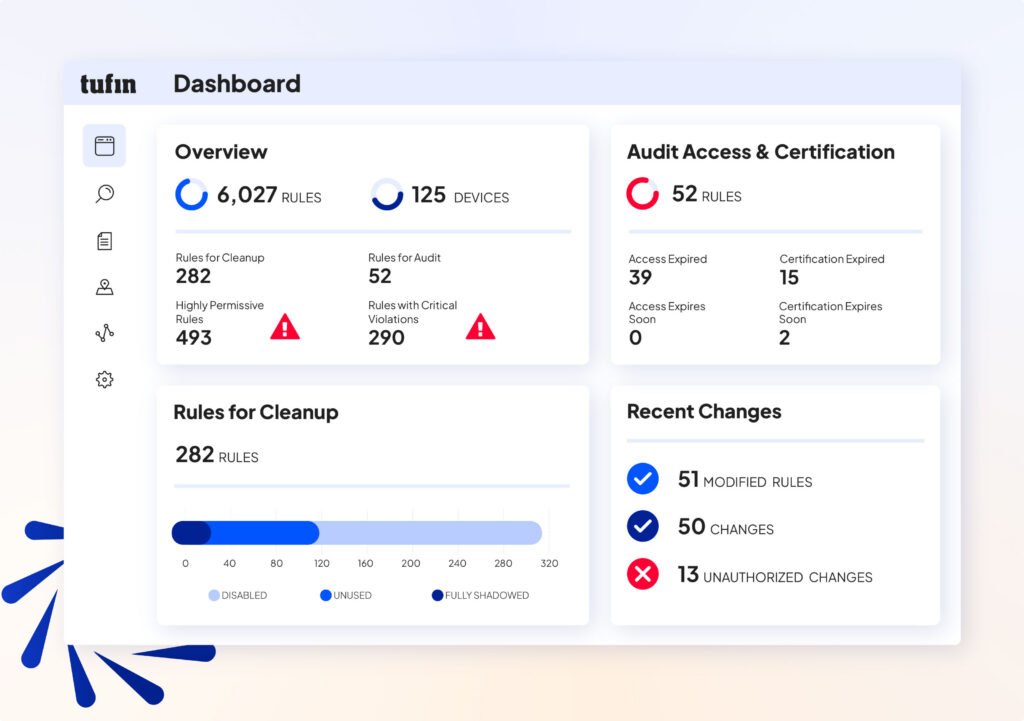Simplify and Secure Your Network Segmentation
Modern hybrid networks are fast-changing, fragmented, and complex, making it difficult to enforce least-privilege access and maintain consistent policies.
Tufin delivers a unified control plane enabling organizations to design, enforce, and continuously monitor segmentation across on-premises, cloud, and hybrid networks.
Why Tufin for Network Segmentation
By combining segmentation with full attack surface visibility, context-aware risk prioritization, and automated workflows, Tufin delivers policy-driven segmentation, securing your entire network at scale.
Full Visibility Across Segments
Map and monitor traffic flows to eliminate security blind spots across hybrid networks.
Risk-Based Enforcement
Apply segmentation where exposures are most critical to reduce lateral movement and security gaps.
Automated Zero Trust Controls
Orchestrate segmentation changes across IT and DevOps with compliance built in.
Continuous Posture Alignment
Validate segmentation against frameworks like NIST, PCI DSS, and DORA with audit-ready reporting.
Network Segmentation Use Cases
How Tufin Delivers Network Segmentation
The Tufin Platform is a comprehensive, AI-driven unified control plane for network security policy management. The platform is comprised of:
SecureTrack+
See every risk before it becomes a problem — with unified visibility, accurate topology mapping, and continuous risk assessment across firewalls, cloud, SASE, and microsegmentation. Automate policy optimization to reduce exposure and ensure continuous compliance.
SecureChange+
Turn slow, error-prone changes into secure, automated workflows. Accelerate delivery and cut SLA times by up to 90% with automated design, rule lifecycle management, and hybrid connectivity troubleshooting that eliminates delays and misconfigurations.
Enterprise
Scale security without slowing innovation. Automate access provisioning, accelerate application connectivity, and ensure uptime with built-in high availability and global scalability for the largest, most complex networks.
Network Segmentation with Tufin
With Tufin, organizations can reduce exposure gaps, automate policy changes, and simplify compliance. Our unified approach ensures every access path is intentional, every segmentation rule is validated, and every policy aligns with Zero Trust principles — delivering measurable risk reduction and ROI.
FAQs
Network segmentation is the practice of dividing a network into smaller segmented networks or subnets to improve network security and performance. By creating separate security zones, organizations control network traffic flows, apply targeted security policies, and reduce the attack surface. Segmentation limits unauthorized access, contains malware outbreaks, and helps protect sensitive data against cyber threats and data breaches.
Tufin helps organizations design and enforce segmentation strategies across on-premises, cloud environments, and hybrid network infrastructure.
- Firewalls and access control lists enforce rules between parts of the network
- VLANs and subnets separate network devices and workloads into logical groups, called segments
- Routers and SDN direct traffic flows between segments
- Authentication and permissions restrict network access to specific zones
These measures prevent attackers from moving laterally across the internal network, reducing the chance that a breach on one system spreads to the entire network.
- Network segmentation creates boundaries between large groups of subnets and data center resources. It improves network performance, reduces network congestion, and enhances cybersecurity by controlling traffic flows at the network perimeter.
- Microsegmentation operates at a finer-grain level, controlling traffic between individual endpoints, apps, or specific workloads within a segmented network. It is often used in Zero Trust security strategies to stop east-west lateral movement.
Both approaches work together: segmentation sets the foundation, while microsegmentation enforces least privilege at a more granular scale.
- Firewalls and access control rules apply restrictions between security zones
- Segmentation policies and automation define how permissions and traffic flows are applied
- Network administrators configure routers, VLANs, and subnets to separate parts of the network
- Continuous monitoring validates security posture and detects unauthorized access or policy drift
Tufin automates segmentation enforcement by aligning security policies with network architecture, ensuring consistent application across on-premises, cloud, and hybrid networks.
- Reduce the attack surface by limiting how much of the internal network is exposed
- Contain threats by isolating malware infections or cyberattacks to a single security zone
- Protect sensitive data and reduce the risk of data breaches
- Support compliance requirements for compliance frameworks like PCI DSS by segregating credit card data and related workloads
- Improve network performance by minimizing network congestion and optimizing traffic flows
Zero Trust security is based on the principle of never trust, always verify, and network segmentation is a key enabler. By dividing the network infrastructure into segmented networks, organizations enforce least privilege, strengthen access policies, and reduce lateral movement. When combined with microsegmentation and continuous authentication, segmentation becomes part of a broader Zero Trust strategy to secure cloud environments, SaaS apps, and on-premises systems.
- Improved security by preventing unauthorized access and reducing the impact of cyberattacks
- Compliance support through meeting regulatory mandates, such as PCI DSS
- Operational resilience by containing malware outbreaks and protecting the entire network
- Performance optimization by reducing network congestion
- Stronger security posture with enforced controls and reduced vulnerabilities
Tufin delivers the benefits of network segmentation by providing centralized visibility and automated enforcement of segmentation policies, ensuring consistency across large, complex, hybrid environments.
- Firewalls that enforce security policies between security zones
- Routers and switches that manage traffic flows across subnets and VLANs
- Access control lists and authentication mechanisms that restrict network access
- SDN and automation platforms that streamline policy enforcement in cloud environments and hybrid networks
- Continuous monitoring solutions that track network traffic and maintain compliance with segmentation policies
Tufin provides a unified control plane that orchestrates the automation of segmentation policies while helping network administrators maintain consistent enforcement across network devices, cloud platforms, and on-premises infrastructure.
Additional Resources
Discover how Tufin automates segmentation enforcement and exposure path validation to mitigate critical risks.
Firewall Management Resources
Articles
Solutions
Get Started with Network Segmentation
See how Tufin unifies segmentation and posture management to make Zero Trust real.




